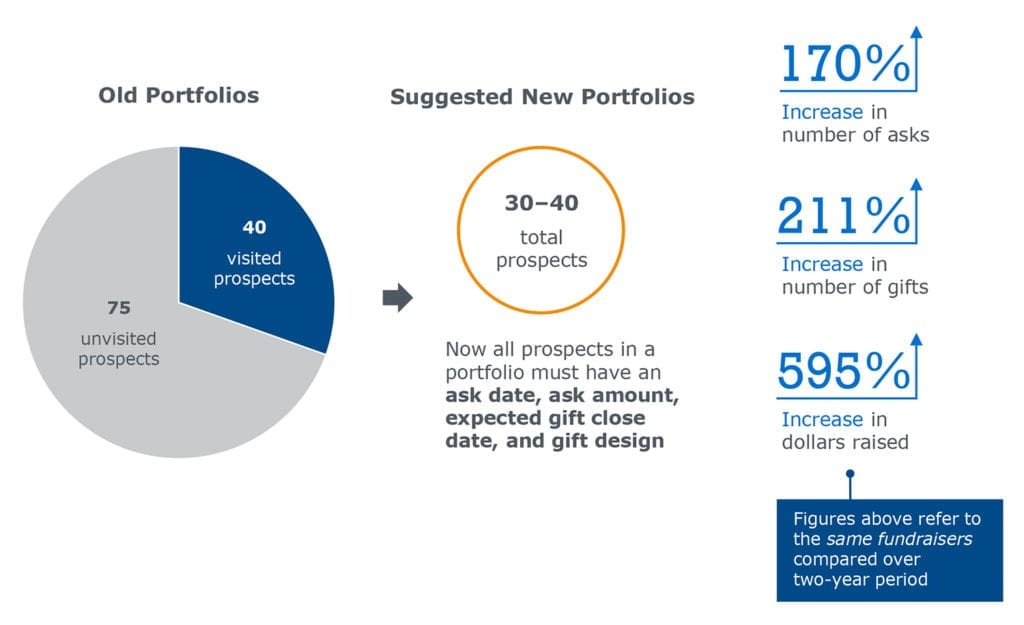What Are the Right Metrics to Measure Major Gift Officer Performance?
Donor pyramids have become increasingly narrow over the past 15 years, raising the stakes for big-gift fundraising. One or two lost gifts at the top could undermine the entire division’s performance. Advancement leaders need their major gift officers to operate at maximum efficiency—but they aren’t able to adequately evaluate whether their fundraisers are performing to expectations without a data-informed system in place .
You can’t discuss major gift officer (MGO) performance management without first talking about metrics. Institutions that have successfully addressed the major gift officer performance dilemma have incorporated metrics into their performance management systems in two key ways:
| Problem without metrics | Example |
|---|---|
| No job definition | New MGOs uncertain of job expectation |
| No rank for prioritizing time | MGO unfocused, does not know best activity to perform |
| No guidance for reaching goal | Large financial target paralyzing without next steps |
| No timely success measure | Outcomes revealed long after efforts made |
| No basis for evaluation | Multiple MGO's performance difficult to judge fairly |
Recommendation #1: Establish individualized and transparent goals
There is no such thing as a set of “magic metrics” that will automatically increase major gift officer productivity. Metrics need to be tailored to each advancement shop’s culture, campaign stage, prospect base, and major gift officer experience.
Instead of engaging in a “game” of reflexive, general, and vague metrics, best practice institutions take a more rigorous approach to create data-based major gift officer goals, communicate clear expectations, and reward performance effectively.
- They rigorously set dollar goals. Instead of haphazardly installing metrics to fix specific conditions within a shop, leading institutions are moving toward a well-planned, holistic, and data-based approach. By calculating the probability that solicitations will occur during a given fiscal year and the probability that those solicitations will close in the same fiscal year, advancement shops can set more realistic MGO fundraising goals.
- They embed metrics into job descriptions. A true commitment to metrics throughout the MGO lifecycle requires starting well before a candidate joins the advancement team. Introducing MGO candidates to their performance grids during the interview process helps to eliminate the surprise factor around performance accountability later on.
- They organize performance information with scorecards. Points systems are an efficient way to organize metrics, distill complex information in order of importance, and allow for weightings of activities that are most central to the institution’s specific goals. Advancement leaders should incorporate cash goals, total contact with prospects, and donor retention metrics into visible and accessible MGO scorecards.
Benefits of using a points system
-
More objective indicator of success than qualitative feedback
-
Easy to integrate into formal performance review
-
Distills massive amount of information into most relevant data points about performance
-
Agile enough to allow for weighting of activities or outcomes most valuable to your shop in a given period
Recommendation #2: Create guardrails against perverse incentives
Metrics systems have great potential to boost overall fundraising, but when they’re built haphazardly, they can do more harm than good. Under intense pressure to perform on number of visits or solicitations, major gift officers might sacrifice the quality of their interactions for higher yield. In addition, MGOs might react negatively to metrics that they deem unfair or overly stringent.
Best practice institutions combat these perverse incentives by motivating major gift officers to improve performance across all metrics, emphasizing quality over quantity, and securing MGO buy-in from the outset.
- They cap total performance points. By capping the total points that a major gift officer can earn on any given metric, advancement shops successfully recognize stellar performance in one particular strength area while still ensuring that MGOs are motivated to improve performance in growth areas.
- They adopt a “less is more” approach. In an effort to increase productivity, many advancement shops are experimenting with decreased visit and solicitation goals, allowing major gift officers to focus more time and attention on designing high-quality proposals for the best prospects. Institutions that have reduced MGO portfolio size have actually seen increases in the number of asks, number of gifts, and overall dollars raised.
- They create consensus through committees. Without securing major gift officer buy-in, the transition to a metrics-based approach will be an uphill battle for advancement leaders. One way we have seen institutions generate buy-in from their Major Gift Officers is through a bottom-up approach. MGOs are asked to sit on a committee, explore potential metrics, reach out to peers on best practices, and present their ideas to the leadership team.
Portfolio size reduction yields manageable prospect pool

This resource requires EAB partnership access to view.
Access the research report
Learn how you can get access to this resource as well as hands-on support from our experts through Advancement Advisory Services.
Learn More